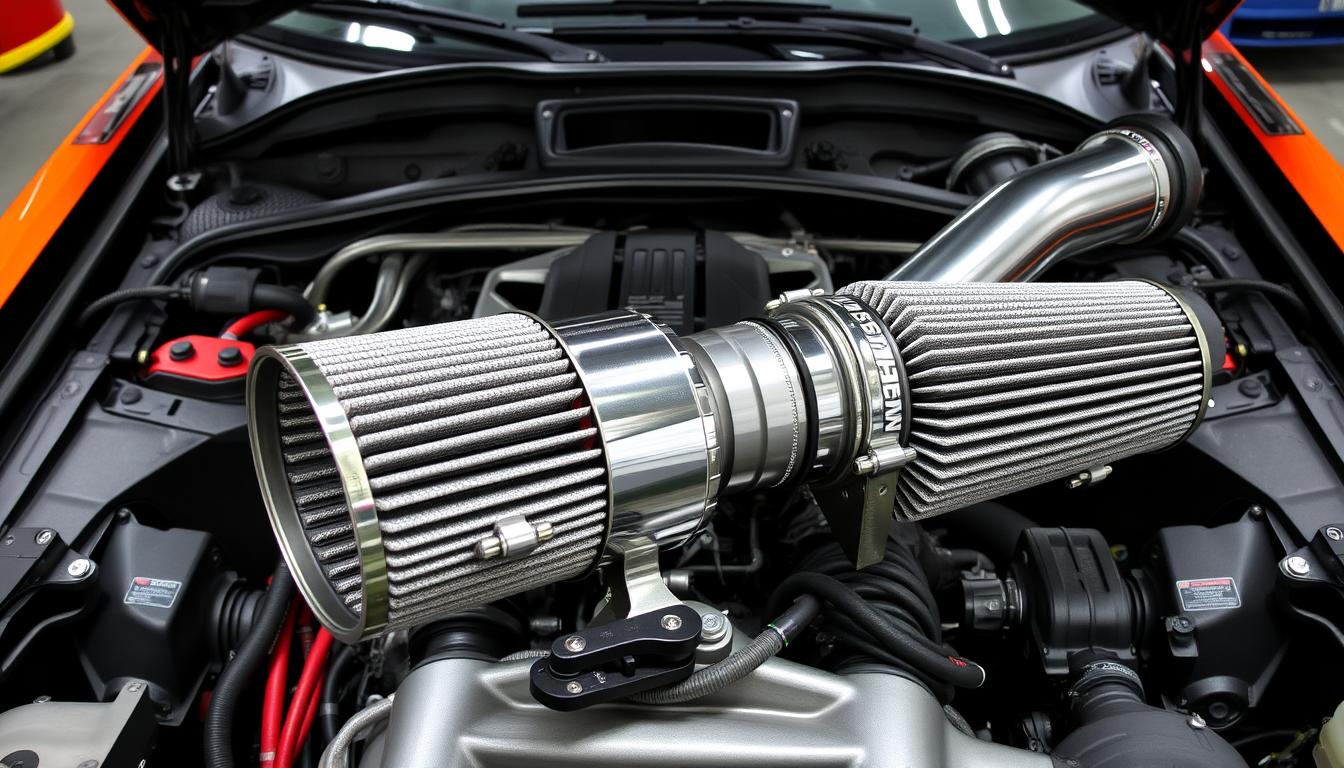Car lovers looking to boost their engine’s power often turn to cold air intake systems. These systems are easy to install and can make a big difference. They help your engine breathe better by pulling in cooler air from outside the engine.
This makes your engine run more efficiently. You might notice your car goes faster, uses less gas, and feels more responsive. It’s a simple way to make your car perform better.
Key Takeaways
- Cold air intakes are a cost-effective way to improve engine performance.
- They improve airflow and allow cooler, denser air into the engine for more efficient combustion.
- Cold air intakes can increase horsepower and torque, as well as improve fuel economy.
- Proper installation and maintenance are crucial for optimal performance and safety.
- Consulting with trusted auto experts is recommended when considering a cold air intake system.
Understanding Cold Air Intake Systems
Cold air intake systems are a top choice for car enthusiasts. They boost engine performance and efficiency. The main parts of a cold air intake system are:
- High-flow air filter: A bigger, reusable air filter lets more air into the engine.
- Larger diameter intake tubes: These wider tubes help air flow better than the factory design.
- Heat shields: They keep the intake system cool, ensuring the best performance.
These performance intakes are different from the standard engine breathing systems. While factory systems meet many needs, cold air intakes focus on better airflow and engine performance.
Basic Components and Design
The design of a cold air intake system aims to improve air intake. It uses a bigger air filter and wider tubing. This lets it draw in more oxygen-rich air, key for efficient combustion and power.
How They Differ from Stock Systems
Unlike factory air intakes, cold air intakes are made to boost engine breathing and performance. They come with reusable air filters. This saves money and helps the environment.
What Does a Cold Air Intake Do
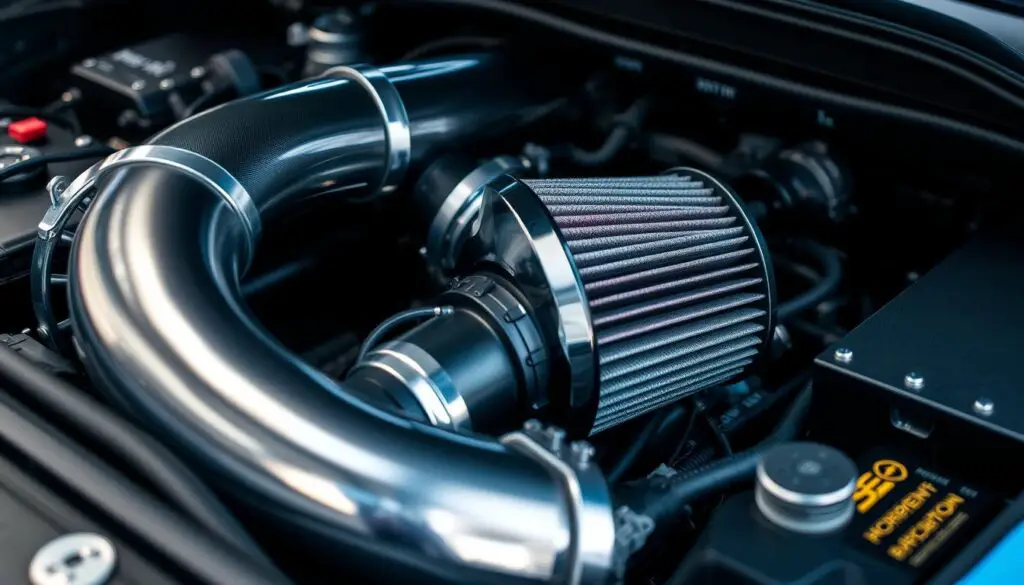
A cold air intake is a key upgrade for your car. It boosts engine performance by improving airflow and cooling the air. This makes your engine run better.
This intake moves the air filter to a cooler spot, like the upper wheel well. This lets the engine get air with more oxygen. This leads to better fuel burning and more power.
- Increased Airflow: A cold air intake system is designed to facilitate greater airflow into the engine, feeding the combustion process with more oxygen-rich air.
- Cooler Air Temperature: By drawing in air from outside the engine bay, a cold air intake system delivers cooler, denser air to the engine, enhancing its efficiency and performance.
- Enhanced Engine Breathing: The improved airflow and cooler air temperature work together to optimize the engine’s breathing capabilities, unlocking additional horsepower and torque.
Drivers often notice a big boost in engine power and speed. A cold air intake makes your car perform better. It helps your car reach its full power potential.
| Benefit | Description |
|---|---|
| Greater Power | A cold air intake system can result in increased horsepower and torque, providing your engine with enhanced responsiveness and acceleration. |
| More Consistent Power | The improved airflow and cooler air temperatures help maintain a more consistent power delivery throughout the engine’s rev range. |
| Better Gas Mileage | By optimizing the engine’s air intake, a cold air intake system can lead to improved fuel efficiency and better gas mileage. |
“The most efficient intake systems utilize an airbox sized to complement the engine, extending the powerband.”
The Science Behind Engine Breathing
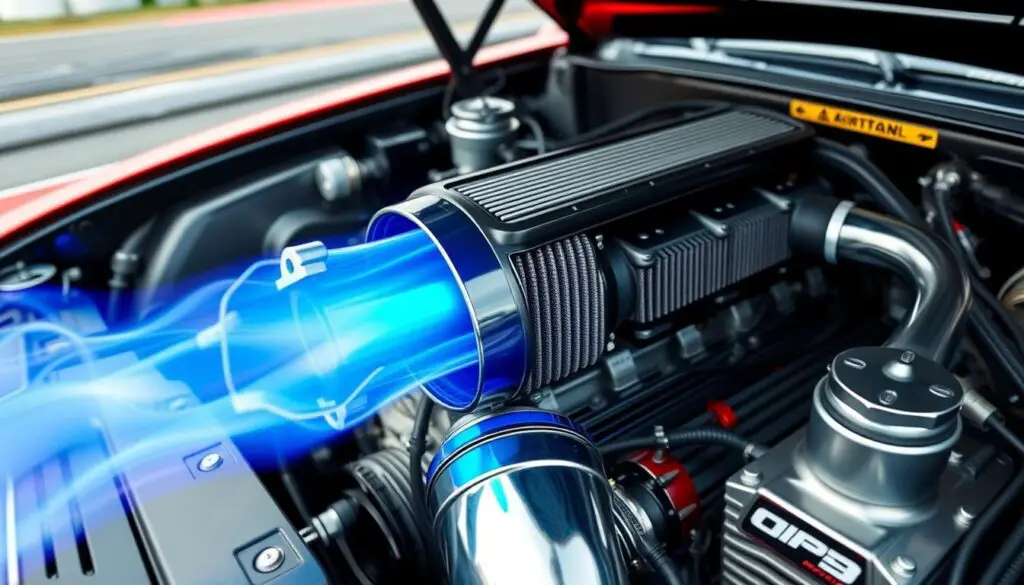
Engine breathing is key to how well an engine works, much like our lungs breathe. The engine’s cylinders take in air for burning fuel. Understanding this process is vital for better power and efficiency.
Air Density and Combustion
Cooler air is denser and has more oxygen than hot air. This means more oxygen-rich air can enter the cylinders. This leads to better fuel combustion and boosts engine performance.
Temperature Effects on Performance
Temperature greatly affects engine performance. Cool air, drawn in by a good intake system, leads to better combustion. This cooler air allows for more efficient burning in the cylinders.
“The importance of taking in cold and fresh air for optimal engine performance cannot be overstated. Engineering the intake to capture this valuable resource is a key step in unlocking the full potential of any engine.”
Fluid dynamics also matter for intake performance. Turbulent airflow mixes air and fuel well in the cylinders. Larger intake ducts move more air with less pressure drop, improving engine breathing.
Performance Benefits of Cold Air Intakes
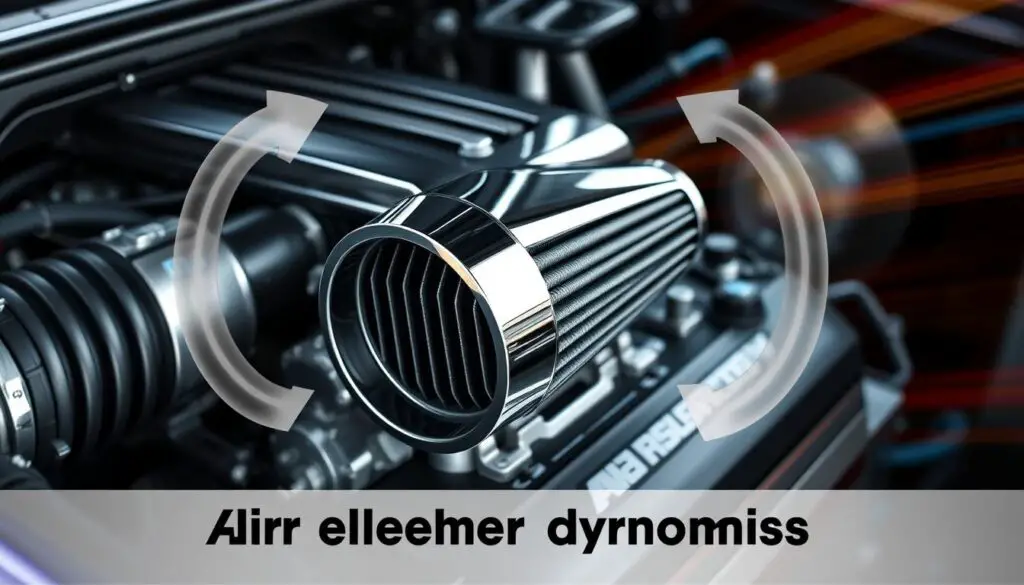
Looking to boost your vehicle’s performance? A cold air intake system can make a big difference. These upgrades bring several benefits that enhance your driving experience.
One key advantage is the increased horsepower and torque. Cold air intakes can add 5 to 20 horsepower. This is because they draw in cooler, denser air for better combustion. You’ll notice a big improvement in acceleration and power.
But there’s more. Cold air intakes also improve fuel economy. They optimize the air-to-fuel ratio, which means better gas mileage. Upgrading can lead to consistent power and better fuel efficiency, saving you money.
Another benefit is the improved throttle response. The increased airflow and cooler intake temperatures make the throttle more responsive. This results in a more engaging and dynamic drive. Many users also enjoy a more aggressive engine sound when accelerating.
| Benefit | Impact |
|---|---|
| Increased Horsepower | Up to 20 additional horsepower |
| Improved Fuel Economy | Enhanced air-to-fuel ratio for better gas mileage |
| Enhanced Throttle Response | More responsive and engaging acceleration |
Upgrading to a cold air intake system unlocks new performance and efficiency levels. Every drive becomes more thrilling and rewarding.
Horsepower and Torque Improvements
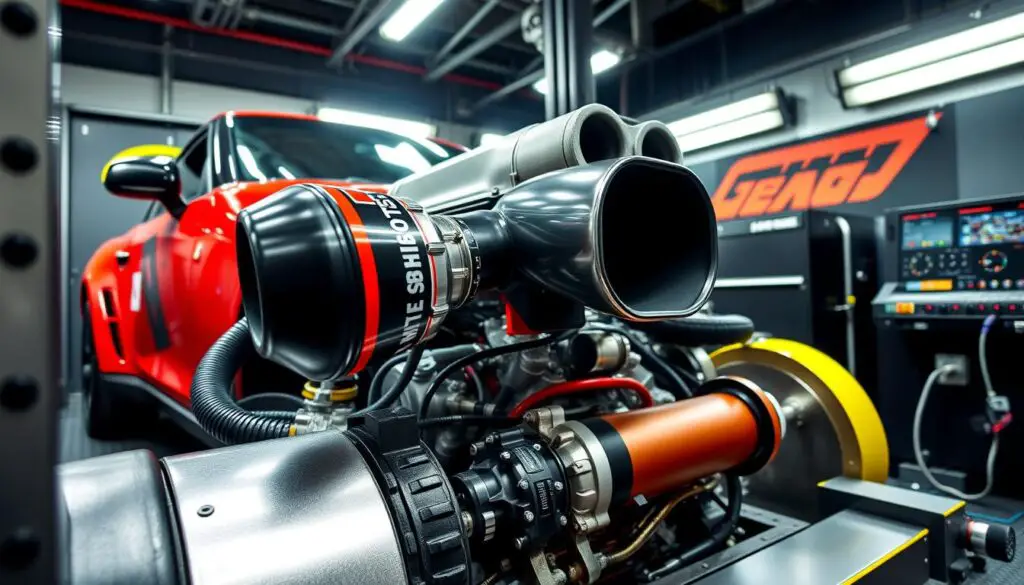
Installing a cold air intake can boost your vehicle’s horsepower and torque. The exact gains vary, but a good intake system brings cooler air and better airflow. This usually means more power from your engine.
Real-World Power Gains
Driving with a cold air intake feels different. You might see a 5 to 20 horsepower increase, depending on your car and the intake. This extra power makes your car accelerate faster and respond better to the throttle.
Dyno Testing Results
Dyno tests show cold air intakes really work. Horsepower gains range from 5 to 15 horsepower, with some claiming up to 20 or 30 horsepower. But, the actual gains depend on your car and the intake system you choose.
| Metric | Average Gain | Maximum Gain |
|---|---|---|
| Horsepower | 5 to 15 HP | 20 to 30 HP |
| Torque | 5 to 15 lb-ft | 15 to 20 lb-ft |
The data shows big horsepower and torque improvements with a quality cold air intake. But, remember, your engine must be able to handle the extra airflow. Choosing a reputable manufacturer is key to avoid any issues or damage.
Impact on Fuel Economy
Getting a cold air intake system can make your car use less fuel. It works by making the engine burn fuel more efficiently. This happens because the intake system brings in cooler, denser air.
This air makes the engine run better, which means you don’t need to fill up as often. People have seen their gas mileage go up by 2-3 miles per gallon. This is true whether they’re driving in the city or on the highway.
The main reason for this better fuel use is the intake system’s effect on combustion. With the engine running smoothly, it needs less fuel to produce power. This leads to better fuel economy for your car.
| Metric | Typical Range |
|---|---|
| Fuel Efficiency Increase | 2-3 mpg |
| Horsepower Boost | 10-30 hp |
| Cost of Cold Air Intake System | $150 to $500 |
The exact amount of fuel savings can vary. It depends on things like where you drive, your car’s model, and how you drive. But, most people see a clear improvement in their fuel efficiency with a cold air intake system.
Types of Cold Air Intake Systems
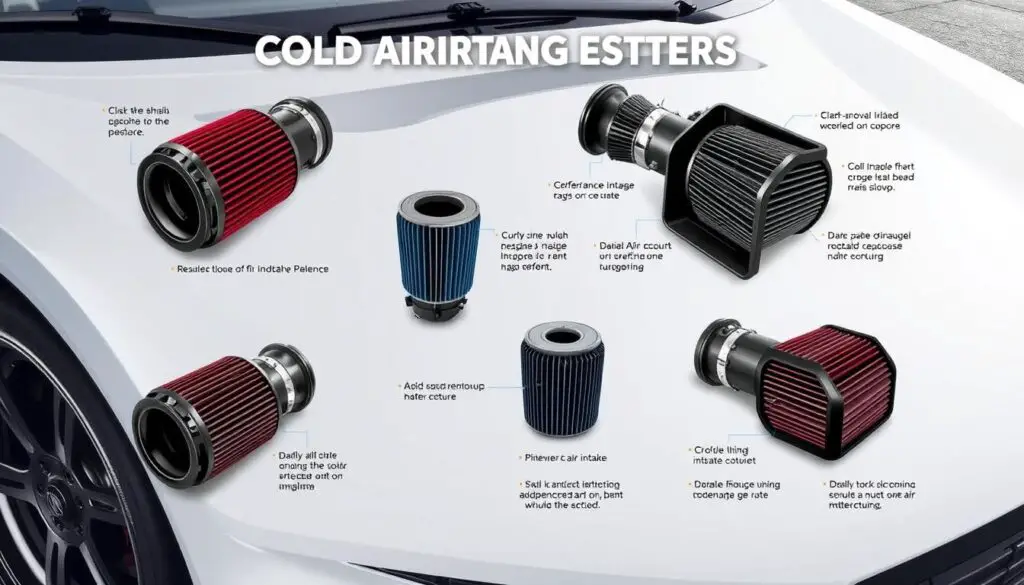
When looking to upgrade your car’s air intake, you have two main choices: short ram intakes and long tube intakes. Each has its own benefits and things to think about for drivers who want better performance.
Short Ram Intakes
Short ram intakes are a good pick for those who want a mix of performance and cost. They have a shorter tube that pulls air from the engine bay, near the throttle body. They don’t cool the air as much as long tube intakes, but they still improve airflow and throttle response.
They’re easy to install and not too expensive, making them popular among car enthusiasts.
Long Tube Intakes
For the biggest performance boost, go for long-tube cold air intake systems. These intakes have a longer tube that reaches outside the engine bay. This lets them pull in cooler, denser air, which means more oxygen for your engine.
This leads to a big increase in horsepower and torque. Long tube intakes are the top choice for those who want the best cold air intake performance. But they need more work to install and it costs a bit more.
Choosing between short ram intakes and long tube intakes depends on your budget, performance goals, and how easy you want installation to be. Both can make your car perform better than the stock air intake system, helping it reach its full potential.
Installation Process and Considerations
Installing a cold air intake is easy and can be done by many car lovers. Most aftermarket upgrade systems are simple to install. They usually take just a few hours. But, it’s important to follow the manufacturer’s instructions carefully to get the best results and avoid problems.
One important thing to do during installation is to make sure everything is sealed well. A good seal keeps the air pressure right and stops leaks. Also, where you put the air filter is key. It affects airflow and can let water in if it’s too low.
- Always read and follow the manufacturer’s instructions to fit everything right and avoid problems.
- Make sure the air filter is in the best spot for airflow. It should not let water in.
- Check that all hoses, clamps, and connections are tight. This keeps the seal strong and stops leaks.
- Think about how the intake system fits with your car and engine. Some designs work better for certain vehicles.
By following these steps and being careful, you can get the most out of your cold air intake. If you’re not sure about anything, it’s smart to ask a pro or look up more help.
| Consideration | Importance |
|---|---|
| Proper Sealing | Maintaining desired air pressure and preventing air leaks |
| Air Filter Placement | Optimizing airflow and avoiding water ingestion |
| Manufacturer Guidelines | Ensuring a proper fit and avoiding complications |
| System Layout | Compatibility with specific vehicle models and engine configurations |
Maintenance Requirements
Keeping your cold air intake system in good shape is key to its long life and best performance. The main thing to focus on is the air filter. Most aftermarket cold air intakes have reusable filters. These can be cleaned and re-oiled when needed.
Experts say cold air intake systems need cleaning or replacement every 30,000-50,000 miles to work at their best. A dirty air filter can cause problems like poor acceleration and engine noise. It can also lower gas mileage and turn on the check engine light.
Following the maker’s instructions for cleaning and looking after the air filter is important. Not doing it right can cause clogs. This can hurt the system’s airflow and your car’s power and gas use.
Also, check the other parts of your cold air intake system occasionally. Look at the tubes and connections to ensure they’re not blocking airflow. Keeping your intake system in top condition will help you get the most out of your cold air intake.
“A clean air filter can add up to 20 horsepower to a vehicle’s performance.”
By sticking to the recommended air filter maintenance schedule and checking your reusable filters often, you can keep your cold air intake system running well. This will help you enjoy better performance and fuel efficiency.
Common Myths and Misconceptions
There are many myths and misconceptions about cold air intake systems. Some people think they will see huge performance gains. Others worry about engine safety. It’s key to know what’s real and what’s not.
Performance Claims
Many believe cold air intakes will boost horsepower and torque a lot. But, the truth is more complex. Premium fuel with higher octane (91-plus) is considered premium fuel, but it may not necessarily improve engine performance for all vehicles. Also, more horsepower doesn’t always mean better performance.
Cold air intakes aim to improve engine performance by better air quality. But they might not live up to all the hype. Tune-ups are thought to improve car performance greatly. Yet, modern parts might offer better results. While capable of enhancing horsepower and torque, performance chip tuning comes with risks such as potential damage to the engine and warranty invalidation.
Engine Safety Concerns
Some think cold air intakes can harm engine safety by letting in water. But, this risk can be lessened with proper installation and the right intake. Cold air intakes might make engines louder, but they don’t damage them if installed and cared for right.
Pedal Commander, a throttle response controller, is not designed to add horsepower but aims to improve the electronic throttle system for better engine response. Misunderstandings about carburetor airboxes, like their effect on airflow and cold weather, are common.
Knowing these myths helps car lovers make better choices about cold air intake. They can enjoy real performance gains without risking engine safety or reliability.
Cost vs. Performance Analysis
The cold air intake is a cost-effective way to boost your car’s performance. It usually costs a few hundred dollars. This upgrade can increase horsepower and torque and even improve fuel efficiency.
A study on a 2012 V6 Ford Mustang showed great results. A Steeda cold air intake system raised the Mass Air Flow (MAF) by about 9% at the engine’s redline. The peak MAF values hit 24,470 ± 90 g/s. This means you get real performance gains.
The Steeda tune with the Steeda CAI outperformed the stock tune with the stock intake. It was faster in vehicle speed and acceleration.
| Tune/Intake Combination | Peak MAF (g/s) | 0-80 mph Acceleration (s) |
|---|---|---|
| Stock Tune with Stock Intake | 22,400 ± 50 | 9.2 |
| Steeda Tune with Stock Intake | 22,510 ± 30 | 8.5 |
| Steeda Tune with Steeda CAI | 24,470 ± 90 | 8.5 |
The cold air intake cost is a good investment for the performance benefits it offers. It’s a great aftermarket upgrade value for car lovers. Plus, it makes your engine sound better and might save on fuel.
Consider your performance goals and budget when thinking about a cold air intake. But, its cost-to-performance ratio is often attractive for those seeking a budget-friendly upgrade.
Conclusion
Aftermarket cold air intake systems boost your car’s performance. They are a smart way to make your engine breathe better and run more efficiently. These upgrades can make your car go faster, use less fuel, and feel more responsive.
The benefits depend on your car, how easy it is to install, and how well you care for it. Cold air intakes usually give you 5-10% more horsepower. Some can even add up to 20 HP. Tests show they also improve acceleration and sound.
When picking and installing a cold air intake, consider your car’s needs and how easy it is to install. Also, remember to keep it well-maintained for the best results. By doing this, car lovers can make their engines perform at their best and enjoy the perks of this upgrade.
FAQs
What is a cold air intake, and how does it work?
What are the main components of a cold air intake system?
How does a cold air intake improve engine performance?
Why is air density important for engine performance?
What are the typical performance benefits of a cold air intake?
How do cold air intakes compare to dyno testing results?
What are the different types of cold air intake systems?
How difficult is it to install a cold air intake?
What are the maintenance requirements for a cold air intake system?
Are there any common myths or misconceptions about cold air intakes?
How do the costs of a cold air intake system compare to the potential performance benefits?

Jack Thompson is a writer and seasoned auto mechanic with over 15 years of experience in the automotive industry. Known for his expertise in vehicle mechanics, Jack has a deep understanding of car and truck systems. His skills, honed through years of hands-on experience, have made him a trusted name in the field. Jack is committed to providing valuable insights into car maintenance and repair, helping vehicle owners keep their vehicles in top condition.

